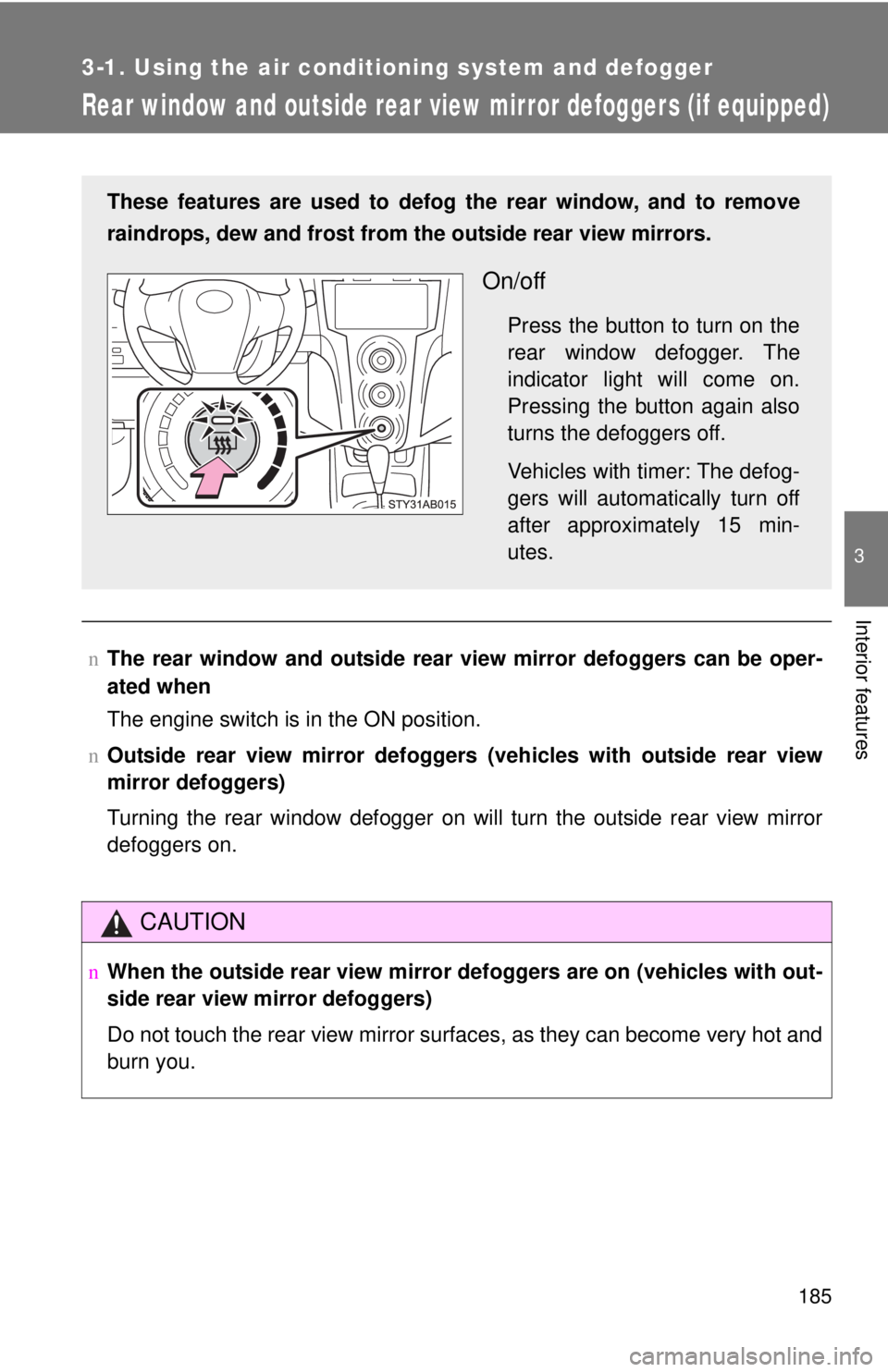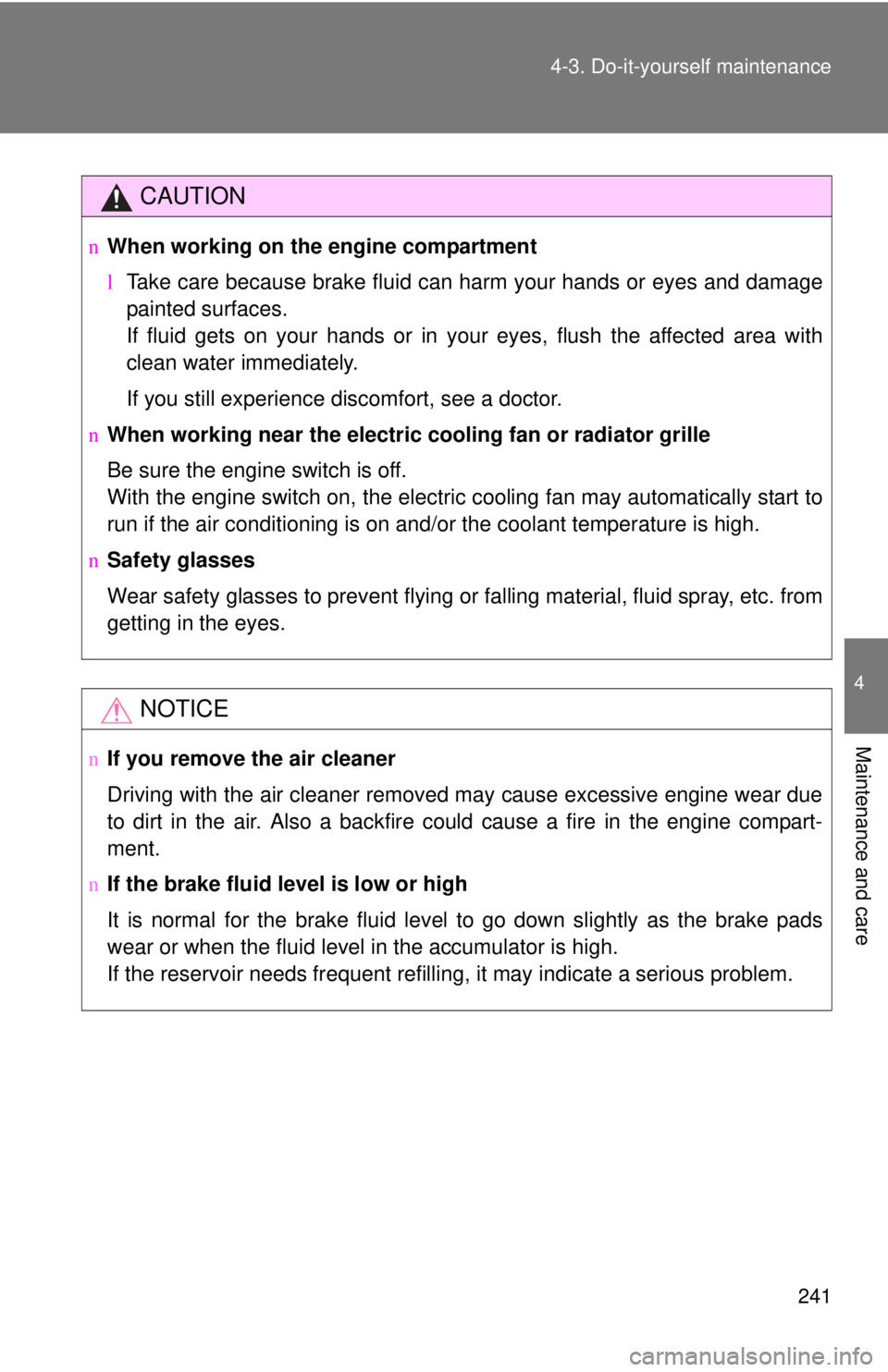Page 194 of 402
182 3-1. Using the air conditioning system and defogger
Direct air flow to the left or right,
up or down.
When defrosting the side win -
dows, face the right and left
side ou
tlets toward them.
Opening and closing the air outlets
Center outlets
Open the vent.
Close the vent.
Page 195 of 402
183
3-1. Using the air conditioning system
and defogger
3
Interior features
Right and left side outlets
Open the vent.
Close the vent.
nUsing the system in recirculated air mode
The windows will fog up more easily if the recirculated air mode is used for
an extended pe
riod.
n When
outside air temperature approaches 32°F (0°C)
The air conditioning system may not operate even when
is pressed.
n When
is selected for the air outlets used
For your driving comfort, air flowing to the feet may be warmer than air flow-
ing to the upper body depending on the position of the temperature adjust -
ment dial.
CAUTION
nTo prevent the windshield from fogging up
Do not set the air outlet selection dial to during cool air operation in
extremely humid weather. The difference between the temperature of the
outside air and that of the windshield can cause the outer surface of the
windshield to fog up, blocking your vision.
Page 196 of 402
184 3-1. Using the air conditioning system and defogger
NOTICE
nTo prevent battery discharge
Do not leave the air conditioning system on longer than necessary when the
engine is stopped.
Page 197 of 402

185
3-1. Using the air conditioning system and defogger
3
Interior features
Rear window and outside rear view mirror defoggers (if equipped)
nThe rear window and outside rear view mirror defoggers can be oper -
ated when
The engine switch is in the ON position.
n Out
side rear view mirror defoggers (vehicles with outside rear view
mirror defoggers)
Turning the rear window defogger on will turn the outside rear view mirror
defoggers on.
CAUTION
n When the outside rear view mirror defoggers are on (vehicles with out-
side rear view mirror defoggers)
Do not touch the rear view mirror surfaces, as they can become very hot and
burn you.
These features are used to defog the rear window, and to remove
raindrops, dew and frost from the outside rear view mirrors.
On/off
Press the button to turn on the
rear window defogger. The
indicator light will come on.
Pressing the button again also
turns the defoggers off.
Vehicles with timer: The defog -
gers will automatically turn off
af
ter approximately 15 min -
utes.
Page 198 of 402
186 3-1. Using the air conditioning system and defogger
NOTICE
nTo prevent battery discharge
Do not leave the rear window defogger on longer than necessary when the
engine is stopped.
Page 252 of 402

241
4-3. Do-it-yourself maintenance
4
Maintenance and care
CAUTION
n
When working on the engine compartment
lTake care because brake fluid can harm your hands or eyes and damage
painted surfaces.
If fluid gets on your hands or in your eyes, flush the affected area with
clean water immediately.
If you still experience discomfort, see a doctor.
n When working near the electric cooling fan or radiator grille
Be sure the engine switch is off.
With the engine switch on, the electric cooling fan may automatically start to
run if the air conditioning is on and/or the coolant temperature is high.
n Safety glasses
Wear safety glasses to prevent flying or falling material, fluid spray, etc. from
getting in the eyes.
NOTICE
nIf you remove the air cleaner
Driving with the air cleaner removed may cause excessive engine wear due
to dirt in the air. Also a backfire could cause a fire in the engine compart-
ment.
n If the brake fluid level is low or high
It is normal for the brake fluid level to go down slightly as the brake pads
wear or when the fluid level in the accumulator is high.
If the reservoir needs frequent refilling, it may indicate a serious pro\
blem.
Page 263 of 402
252 4-3. Do-it-yourself maintenance
Radiator and condenser
Check the radiator and condenser and clear any foreign objects.
If either of the above parts are extr e
mely dirty or you are not sure of
their condition, have your vehicl e checked by your Toyota dealer.
Brake fluid
nChecking fluid level
The brake fluid level should be
b
etween the MAX and MIN lines
on the reservoir.
n Adding fluid
Make sure to check the fluid type and prepare the necessary items.
CAUTION
n When the engine is hot
Do not touch the radiator or condenser as they may be hot and may cause
burns.
Fluid type FMVSS No.116 DOT 3 or SAE J1703 brake fluid
n Brake fluid can absorb moisture from the air
Excess moisture in the fluid can cause a dangerous loss of braking effi -
ciency. Use only newly opened brake fluid.
Page 274 of 402
263
4-3. Do-it-yourself maintenance
4
Maintenance and care
NOTICE
nRepairing or replacing tires, wheels and tire pressure warning
valves and transmitters
When removing or fitting the wheels, tires or the tire pressure warning
valve and transmitter, contact your To
yota dealer as the tire pressure
warning valve and transmitter may be damaged if not handled correctly.
nTo avoid damaging the tire pressure warning valves and transmit-
ters
Do not use liquid sealants on flat tires.
nDriving on rough roads
Take particular care when driving on roads with loose surfaces or pot-
holes.
These conditions may cause losses in tire inflation pressure, reducing
the cushioning ability of the tires. In addition driving on rough roads may
cause damage to the tires themselves, as well as the vehicle's wheels
and body.
nIf tire inflation pressures become low while driving
Do not continue driving, or your tires and/or wheels may be ruined.